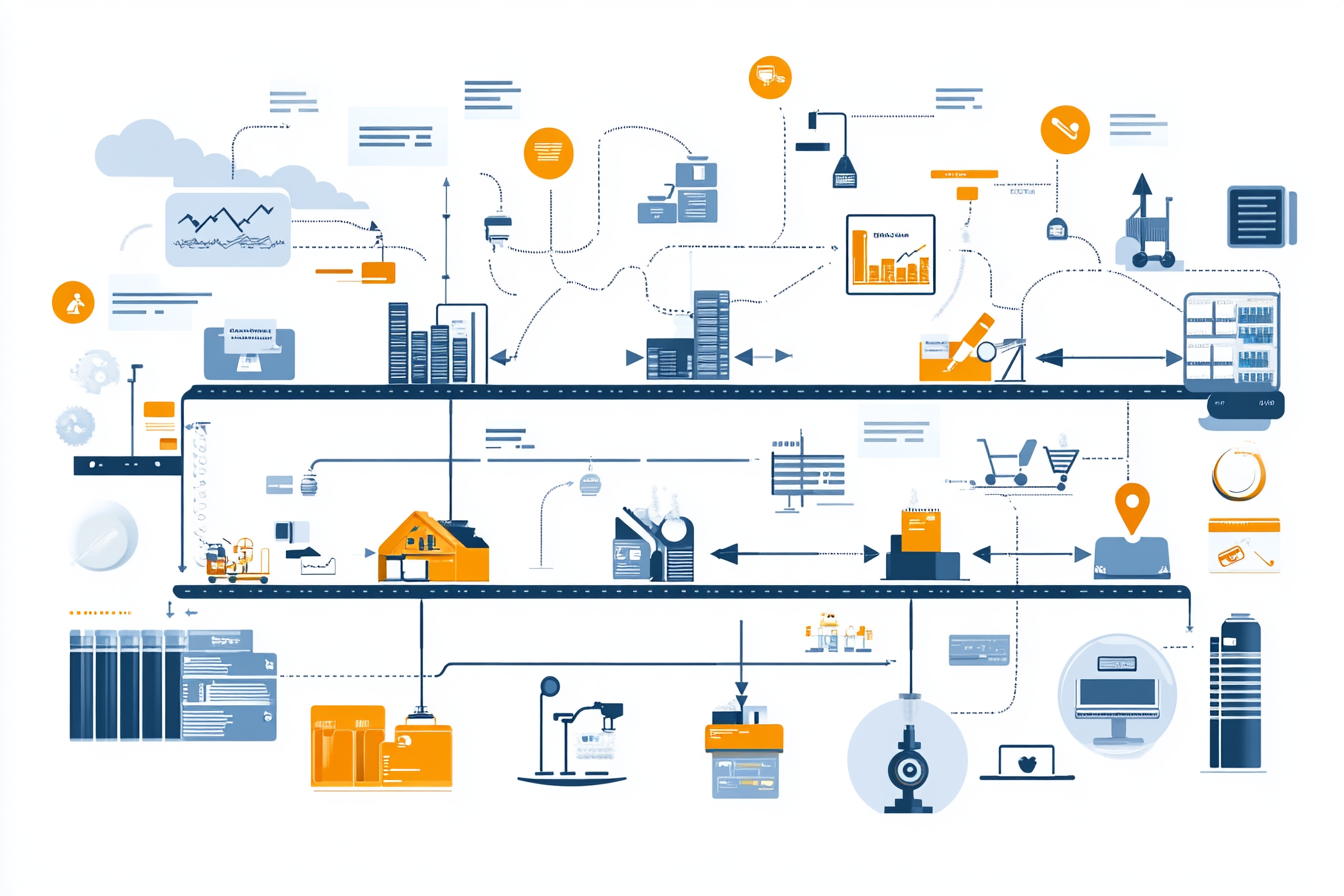Data automation is a transformative approach that leverages technology to streamline the collection, processing, and storage of data, significantly reducing the need for human intervention. By automating data management tasks, organizations can harness the power of data for improved decision-making and operational efficiency.
Key Takeaways
- What is Data Automation?: Data automation involves using technology to collect, process, and store data with minimal human intervention, enhancing efficiency in data handling.
- Benefits of Data Automation: Improved data quality, cost savings, enhanced productivity, and faster analytics.
- Challenges: Integration with legacy systems, initial investment costs, and the learning curve associated with new tools.
- Effective Implementation Strategies: Setting clear objectives, leveraging scalable solutions, and continuous monitoring and optimization post-implementation.
Learn more about Data Automation solutions and services at ipsom.io.
Understanding Data Automation
- Data Automation: A vital process that enhances how businesses manage their data.
- Increased Efficiency: Automating data tasks leads to less time on manual processes and more focus on strategic decision-making.
Definition and Importance
- Automation in Data Handling: Involves using technology to manage data with minimal human input.
- Optimal Decision-Making: Crucial for informed decisions and boosts operational efficiency.
- Smooth Data Flow: Enables organizations to react promptly to changing conditions.
The Data Automation Process
The data automation process is anchored in the ETL framework, which consists of three main steps:
- Extract:
- Gather data from multiple sources such as databases, APIs, and spreadsheets.
- Transform:
- Cleanse and organize the data for analysis.
- Tasks may include removing duplicates or correcting errors.
- Load:
- Store the transformed data in a centralized location for easy access and reporting.
Types of Data Automation
Data automation can be categorized into several types:
- Data Integration:
- Combines data from various sources into one cohesive structure.
- Data Orchestration:
- Manages the flow of data between different systems, ensuring timely data availability.
- Robotic Process Automation (RPA):
- Automates repetitive tasks across applications, allowing human resources to tackle more complex duties.
These categories highlight the versatility of data automation, proving essential across various facets of business operations.
Benefits of Data Automation
The benefits of data automation are numerous and transformative. By automating various data processes, organizations can unlock substantial advantages crucial for growth and efficiency.
Increased Efficiency and Productivity
Data automation significantly reduces the time spent on manual data tasks. Teams can automate repetitive tasks, which allows them to focus more on strategic initiatives. This shift in focus can drive innovation and lead to better business outcomes.
Improved Data Quality and Accuracy
Automation minimizes human errors during data handling. This results in higher accuracy and reliability of the data. Consistent processing ensures that the information used for decision-making is valid and trustworthy.
Cost Reduction and Scalability
Streamlined processes through automation can lead to significant cost savings. Organizations can manage growing volumes of data without increasing labor costs. This scalability ensures that as a business expands, its operations can grow efficiently.
Enhanced Decision-Making
With automated systems, organizations gain quicker access to vital information. This timely access allows for more informed decisions, enabling businesses to react swiftly to market changes or internal needs. Enhanced decision-making contributes to maintaining a competitive edge in the industry.
Challenges in Data Automation
Data automation offers numerous benefits, but it comes with its own set of challenges. Identifying these issues is crucial for successful implementation.
Integration Issues
- Complex Integration: Integrating data automation with legacy systems can be particularly challenging.
- Outdated Technology: Many organizations struggle with technology that does not support new automation tools.
- Middleware Solutions:
- Consider adopting middleware solutions to bridge the gap between old and new systems.
- These tools ensure a smooth data flow and enhance operational efficiency.
Data Quality Management
- Importance of Data Accuracy: Maintaining data accuracy and preventing duplication are vital in automated processes.
- Regular Checks and Balances: Organizations must implement procedures to monitor data integrity.
- Data Validation Tools:
- Utilize data validation tools to identify errors early.
- Establish strict protocols for data entry to enhance consistency in automated workflows.
Security and Compliance
- Security Concerns: Data automation raises significant security and compliance issues, especially with regulations like GDPR and CCPA.
- Prioritize Data Security: Ensure that data security is a fundamental aspect of your automation tools.
- Implement Safeguards:
- Use encryption and access controls to protect sensitive information.
- Conduct regular audits to ensure compliance with evolving regulations.
Skill Gaps
- Skill Gap in Workforce: There is a notable skill gap regarding data automation in the workforce.
- Specialized Knowledge: Many employees may lack the specialized knowledge in automation tools and processes.
- Training Programs:
- Organizations should invest in training programs to upskill existing staff.
- Collaborate with educational institutions to build a pipeline of skilled talent in the field.
By addressing these challenges, companies can effectively leverage data automation to enhance efficiency while mitigating risks.
Strategies for Effective Data Automation
Implementing data automation effectively requires strategic planning. Here are some key strategies to consider:
- Set Clear Goals: Align your automation efforts with overarching business objectives.
- Identify Specific Problems: Focus on the particular issues you aim to resolve through automation.
Setting Clear Objectives
- Establish Clear Objectives: Define what needs automation and outline expected outcomes.
- Focus for Productivity: Ensure that automation efforts remain productive and aligned with business strategies.
Planning for Integration
- Integrate with Existing Systems: Effective integration of data automation is crucial for success.
- Choose Flexible Solutions: Opt for solutions that can adapt to your evolving business needs.
- Minimize Disruptions: A well-planned integration strategy enhances efficiency and reduces potential issues.
Incremental Implementation
- Adopt an Incremental Approach: Begin with pilot projects to evaluate effectiveness.
- Monitor Results: This method allows for adjustments based on performance before scaling up.
- Continuous Optimization: Post-implementation, ensure that systems remain efficient and relevant through ongoing optimization.
Selecting the Right Tools
- Choose the Right Tools: Selecting appropriate tools is vital for successful data automation.
- Key Features to Consider:
- Scalability
- Observability
- Security
- Integration Capabilities
- User-Friendliness
Embark on your journey towards effective data automation by leveraging these strategic approaches to maximize your success and efficiency.
Applications of Data Automation Across Industries
Data automation is revolutionizing various industries by enhancing processes and efficiency. Companies are leveraging technology to streamline operations, making their workflows more effective.
Retail
- Inventory Management: Automated systems track stock levels in real-time.
- Availability: Ensures products are available as needed.
- Personalized Customer Experiences: Utilizes data analytics to boost sales and customer loyalty.
Healthcare
- Management of Patient Records: Automation reduces manual errors.
- Improved Patient Care: Leads to better patient outcomes.
- Efficient Data Handling: Allows quick access to vital information and streamlines administrative tasks.
Accounting
- Bookkeeping Processes: Data automation enhances accuracy in financial reporting.
- Compliance: Helps businesses maintain compliance effectively.
- Focus on Analysis and Strategy: Reduces manual data entry, enabling accountants to concentrate on higher-level tasks.
Manufacturing
- Predictive Maintenance: Utilizes data analysis to foresee equipment failures.
- Reduced Downtime: Proactive strategies minimize production interruptions.
- Cost Savings and Improved Efficiency: Optimizes production processes significantly.
For tailored automation solutions in various industries, consult with ipsom.io.
Data Automation Tools and Technologies
The right data automation tools are essential for successful implementation. These tools simplify processes and enhance productivity across various industries. Understanding the capabilities of these tools enables organizations to make informed choices tailored to their specific needs.
ETL Tools and Their Importance
ETL tools play a critical role in data automation. They assist in the Extract, Transform, Load (ETL) process, allowing efficient management of large datasets. Notable tools, like the Databricks Lakehouse Platform, provide robust solutions for data engineering. They facilitate easy streaming and processing of data. Another tool, Delta Live Tables (DLT), simplifies ETL workflows, enabling quick transformation and analysis of real-time data.
Monitoring and Maintenance
Regular monitoring and maintenance of automation tools are vital. This ensures that data flows are error-free and the system functions optimally. By implementing monitoring strategies, organizations can quickly identify and rectify issues, protecting data integrity and maintaining performance.
Integration with Other Tools
Successful data automation relies on integration with existing tools and systems. This connectivity fosters the creation of efficient workflows, allowing seamless data exchange. Organizations should focus on selecting automation tools that easily integrate with their current IT infrastructure, ensuring a smooth process and enhanced functionality.
By leveraging the right tools and technologies, businesses can streamline their data automation efforts, leading to improved efficiency and better decision-making.
FAQ
What is the ETL process in data automation?
The ETL process stands for Extract, Transform, Load. It involves gathering data from various sources (Extract), cleaning and organizing that data for analysis (Transform), and then storing it in a suitable location for decision-making (Load). This process is crucial for ensuring data is usable and reliable.
How does data automation improve data quality?
Data automation minimizes human errors associated with manual data entry and processing. By standardizing the data handling processes, consistency and reliability are achieved, leading to overall improved data quality.
What are the common challenges of implementing data automation?
Key challenges include integration issues with legacy systems, managing data quality, ensuring security and compliance, and addressing skill gaps within the workforce. Organizations must strategize to overcome these hurdles for successful implementation.
How can organizations select the right data automation tools?
Organizations should consider several key features while selecting tools for data automation. Look for scalability, integration capabilities, and user-friendliness. Tools should meet the specific needs of the organization and adapt to evolving business requirements.
What industries benefit most from data automation?
Nearly every industry can benefit from data automation, but sectors like retail, healthcare, accounting, and manufacturing see significant improvements. Automation can enhance efficiency, reduce errors, and streamline operations in these areas.
How does data automation integrate with existing IT systems?
Data automation integrates with existing IT systems through the use of APIs, connectors, and ETL tools. Proper planning and flexible solutions aid in seamless integration, allowing organizations to leverage automated processes without disruption.
What role do data engineers play in the data automation process?
Data engineers are essential in building and maintaining the infrastructure required for data automation. They design ETL processes, manage data pipelines, and ensure that data flows smoothly across systems, optimizing automation efforts.
How should organizations monitor data automation performance?
Organizations should regularly track key performance indicators (KPIs) related to data flows, accuracy, and processing times. Utilizing monitoring tools and maintaining an ongoing evaluation process is vital to ensure optimal performance of automated systems.
What training is required for teams to effectively use data automation tools?
Teams need training in specific automation tools, data handling best practices, and basic programming or scripting skills. Continuous education and workshops help teams stay updated with the latest advancements in data automation.
For more insights on data automation, visit ipsom.io.






